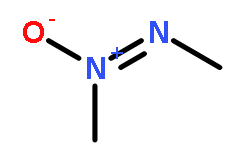| 中文名称: | 偶氮甲烷 热销 | ||||
|---|---|---|---|---|---|
| 英文名称: | Azoxymethane | ||||
| 别名: | 氧化偶氮甲烷 AOM | ||||
| CAS No: | 25843-45-2 | 分子式: | C2H6N2O | 分子量: | 74.08 |
| CAS No: | 25843-45-2 | ||||
| 分子式: | C2H6N2O | ||||
| 分子量: | 74.08 | ||||
产品简介:
一种基因突变剂,可与硫酸葡聚糖钠(DSS)一起用于在实验室动物中创建癌症模型,从而用于研究癌症进展和化学预防的机制。
激酶实验:
The assay for Azoxymethane-induced in vitro DNA adduct formation is performed. Briefly, microsomes (0.5 to 2.0 mg/mL) are incubated with calf thymus DNA (1 mg/mL) and Azoxymethane (200 μM) in a total volume of 1.0 mL. The assay buffer consists of 0.1 M Tris-HCl (pH 7.4), 1 mM EDTA, 20 mM MgCl2, 0.3 M KCl, and 1.5 mM NADPH. Incubations are carried out at 37°C for 60 min in a shaking water bath. An additional 30 nM of NADPH is added after the first 30 min. The reaction is stopped by the addition of 0.5 mL of ice-cold 7.5 M ammonium acetate. DNA is then extracted for tissue homogenates. Control incubations are performed without NADPH.
动物实验:
Male, 8 to 10 week old, WT-A/J, IECN-A/J, and LCN-A/J mice (8 per group) are treated with either saline or Azoxymethane (7.5 mg/kg BW, s.c.), once weekly for 3 weeks. Mice are sacrificed 6 weeks post-treatment for aberrant crypt foci (ACF) detection. The entire colon is excised. A longitudinal incision is made along the entire length of the colon, which is further cut into two equal-length segments, representing proximal and distal portions of the colon. The segments are dipped in PBS to remove fecal pellets and then kept flat between filter papers in 10% buffered formalin for at least 24 h. Subsequently, the colons are immersed in freshly prepared 0.1% methylene blue for 10 min and rinsed briefly in deionized H2O to remove excess dye. The colon is mounted carefully on a microscope slide with the mucosal surface side up and viewed under a light microscope.
The ACF in the entire mucosal surface of the colon are counted blindly and independently by two investigators and recorded。
The ACF in the entire mucosal surface of the colon are counted blindly and independently by two investigators and recorded。
操作步骤:
生化机理:
Azoxymethane is a colon carcinogen which leads to the formation of DNA adducts. On an equal protein basis, hepatic microsomes are much more active than SI and colon microsomes in NADPH-dependent Azoxymethane bioactivation and N7- mG adduct formation. Hepatic microsomes show the highest activity in the hydroxylation of Azoxymethane, followed by SI and colon microsomes.
Regardless of the strain, the amounts of O6-mG and N7-mG produced by Azoxymethane are highest in the liver, followed by proximal and distal colons, which have similar levels, and then by duodenum, jejunum and ileum. Results indicate that the Azoxymethane-induced DNA adduct formation in the SI and colon does not depend on bioactivation by hepatic P450 enzymes. Irrespective of the mouse strain, no aberrant crypt foci (ACF) is detected in the colons of saline-treated mice; in contrast, colonic ACF is detected in all three strains of Azoxymethane-treated mice. The Azoxymethane-treated athymic mice have approximately an 11-fold lower tumor incidence than similarly treated WT animals.
Azoxymethane is a colon carcinogen which leads to the formation of DNA adducts. On an equal protein basis, hepatic microsomes are much more active than SI and colon microsomes in NADPH-dependent Azoxymethane bioactivation and N7- mG adduct formation. Hepatic microsomes show the highest activity in the hydroxylation of Azoxymethane, followed by SI and colon microsomes.
Regardless of the strain, the amounts of O6-mG and N7-mG produced by Azoxymethane are highest in the liver, followed by proximal and distal colons, which have similar levels, and then by duodenum, jejunum and ileum. Results indicate that the Azoxymethane-induced DNA adduct formation in the SI and colon does not depend on bioactivation by hepatic P450 enzymes. Irrespective of the mouse strain, no aberrant crypt foci (ACF) is detected in the colons of saline-treated mice; in contrast, colonic ACF is detected in all three strains of Azoxymethane-treated mice. The Azoxymethane-treated athymic mice have approximately an 11-fold lower tumor incidence than similarly treated WT animals.
注意事项:
本产品为少量粘稠液体,包装为棕色离心管,使用前请离心。
1、为了您的安全和健康,请穿实验服并戴一次性手套操作。
2、以上信息仅做参考交流之用。
1、为了您的安全和健康,请穿实验服并戴一次性手套操作。
2、以上信息仅做参考交流之用。
保存条件:
-20℃
UN码:
HazardClass:
危害声明:
安全说明:
搜索质检报告(COA)
参考文献 & 客户发表文献
本计算器可帮助您计算出特定溶液中溶质的质量、溶液浓度和体积之间的关系,公式为:
质量 (g) = 浓度 (mol/L) x 体积 (L) x 分子量 (g/mol)
摩尔浓度计算公式
用本工具协助配置特定浓度的溶液,使用的计算公式为:
开始浓度 x 开始体积 = 最终浓度 x 最终体积
稀释公式
稀释公式一般简略地表示为:C1V1 = C2V2 ( 输入 输出 )








